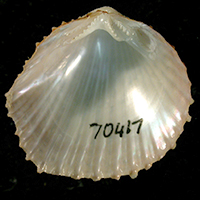|
< Previous family introduction |
|
|||||
 |
Family Trigoniidae Brooch Shells
|
|||||
|
The Trigoniidae had been long known to European palaeontologists and regarded as extinct until 1802 when the French naturalist Francois Péron, as a member of Nicolas Baudin’s Expedition, discovered recent shells on the beach at Adventure Bay, Bruny Island, Tasmania. Twenty-five years later the discovery of living specimens in southern Western Australia by the French naturalists Jean René Constant Quoy and Joseph Paul Gaimard established that the family had survived in southern Australia when it became extinct elsewhere. The family had existed with the genus Eotrigonia for 40 million years, with the currently existing genus Neotrigonia arising 15 million years ago. Fossil Trigoniidae were extremely diverse, with about 50 genera recognised, but extent species number about seven, all in the genus Neotrigonia. There are four species of Neotrigonia living in NSW, two species confined to Western Australia, and one additional species that reaches across tropical northern Australia spanning three jurisdictions. The recognised species are: Neotrigonia gemma Iredale, 1924 Queensland southwards to Victoria Neotrigonia jacksoni H. Morrison, 2011 Central to northern Western Australia Neotrigonia kaiyomaruae Habe & Nomoyto, 1976 Southwestern Western Australia Neotrigonia lamarckii (J.E. Gay, 1838) Central Queensland and NSW Neotrigonia margaritacea (Lamarck, 1804) Southern Australia and Tasmania Neotrigonia strangei (A. Adams, 1854) Southern Queensland and NSW Neotrigonia uniophora (J.E. Gray, 1847) Northern Australia
Trigoniids live subtidally in sand or mud, buried to a depth of about 40 mm. They are active burrowers with a strong foot. They live sufficiently shallowly to be commonly washed up on beaches in Tasmania, but only rarely so in NSW. Shells have been dredged alive in Sydney Harbour, but separated valves, which may be fossil, are more common. Coleman (1981) reported that they are found down to 80 m by SCUBA diving, but museum specimens have been dredged down to 150 m. Family Reference The only consolidated reference to the Australian Trigoniidae is Lamprell & Whitehead (1992). Ana Glavinic wrote a Ph.D. thesis on the group, but it has not been published. Coverage All the species known from NSW are detailed here. Identification Notes Species are readily assigned to Trigoniidae by the schizodont hinge consisting of two very strong blade-like teeth in one valve and two matching sockets in the other, as well as by the nacreous interior. Recognition of the species is not so straight forward as it relies on external shell sculpture, which can be quite variable. Additional Species Neotrigonia uniophora (J.E. Gray, 1847) This tropical northern Australian species has previously been reported from NSW, but I can find no NSW specimens in the Australian Museum collection. It was not recorded from NSW in Iredale & McMichael’s checklist of 1962. Therefore, I conclude that NSW records are probably misidentification of N. strangei.
|
|||||